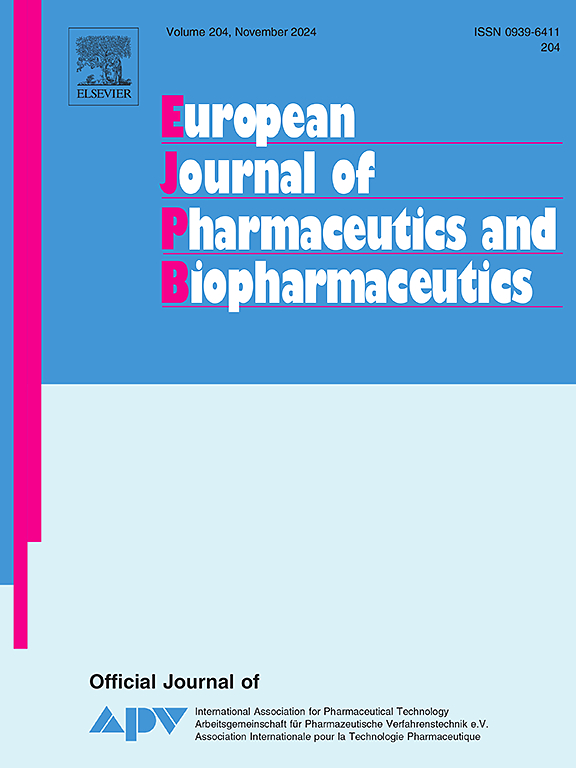Elucidating structure of endogenous phospholipids on in vivo absorption of octreotide following lung administration
IF 4.4
2区 医学
Q1 PHARMACOLOGY & PHARMACY
European Journal of Pharmaceutics and Biopharmaceutics
Pub Date : 2025-03-31
DOI:10.1016/j.ejpb.2025.114706
引用次数: 0
Abstract
Phospholipids as endogenous pulmonary components have received extensive attention on promoting the transmembrane absorption of peptides and proteins. However, considering their diversified structure, influence of phospholipid structural characteristics on drug absorption across lung epithelial cells, together with the underlying absorption-promoting mechanisms, remain unclear. Therefore, in this study, taking octreotide as a model drug, phospholipids with different “tail” and “head” structures were adopted in the form of blank liposomes to investigate their structural characteristics on drug absorption utilizing both 3D Transwell cell models and Sprague Dawley rats. It was demonstrated that indeed the absorption-enhancing capacity of phospholipids was their structure-dependent. Among the tail (non-polar) structures, a moderately increased alkyl chain length could facilitate drug absorption across the pulmonary epithelium, with the highest enhancement ratio observed for Dipalmitoyl Phosphatidylcholine (DPPC) containing a palmitoyl group of 16 carbons, and its apparent permeability coefficient (Papp) increased 2.4 times compared to octreotide solution. Among the head (polar) structures, charged functional groups could contribute to better drug permeation, and Dipalmitoyl Phosphatidylserine (DPPS) containing a protonated amino (![]() NH3+) and a deprotonated carboxyl (
NH3+) and a deprotonated carboxyl (![]() COO-) exhibited a 4.6-fold increase in Papp compared to octreotide solution. Mechanism studies disclosed a paracellular pathway-mediated drug transport across lung epithelial cells. In summary, phospholipids can serve as biosafe absorption enhancers for pulmonary drug delivery, with the extent depending on their structure, which could provide a theoretical basis for pulmonary delivery of macromolecules for systemic absorption.
COO-) exhibited a 4.6-fold increase in Papp compared to octreotide solution. Mechanism studies disclosed a paracellular pathway-mediated drug transport across lung epithelial cells. In summary, phospholipids can serve as biosafe absorption enhancers for pulmonary drug delivery, with the extent depending on their structure, which could provide a theoretical basis for pulmonary delivery of macromolecules for systemic absorption.

阐明内源性磷脂结构对奥曲肽肺给药后体内吸收的影响。
磷脂作为内源性肺成分在促进多肽和蛋白质的跨膜吸收方面受到广泛关注。然而,由于磷脂结构多样,其结构特征对药物在肺上皮细胞间吸收的影响及其促进吸收的机制尚不清楚。因此,本研究以奥曲肽为模型药物,采用空白脂质体的形式,采用具有不同“尾”和“头”结构的磷脂,利用3D Transwell细胞模型和Sprague Dawley大鼠研究其对药物吸收的结构特征。结果表明,磷脂的吸收增强能力是由其结构决定的。在尾部(非极性)结构中,烷基链长度的适度增加有助于药物通过肺上皮的吸收,含有棕榈酰16个碳的双棕榈酰磷脂酰胆碱(DPPC)的增强率最高,其表观通透系数(Papp)比奥曲肽溶液增加2.4倍。在头部(极性)结构中,带电官能团有助于更好的药物渗透,与奥曲肽溶液相比,含有一个质子化氨基(NH3+)和一个去质子化羧基(COO-)的双棕榈酰磷脂酰丝氨酸(DPPS)的Papp增加了4.6倍。机制研究揭示了一种细胞旁通路介导的药物在肺上皮细胞间的转运。综上所述,磷脂可以作为药物肺传递的生物安全吸收促进剂,其作用程度取决于其结构,这为大分子药物肺传递系统吸收提供了理论基础。
本文章由计算机程序翻译,如有差异,请以英文原文为准。
求助全文
约1分钟内获得全文
求助全文
来源期刊
CiteScore
8.80
自引率
4.10%
发文量
211
审稿时长
36 days
期刊介绍:
The European Journal of Pharmaceutics and Biopharmaceutics provides a medium for the publication of novel, innovative and hypothesis-driven research from the areas of Pharmaceutics and Biopharmaceutics.
Topics covered include for example:
Design and development of drug delivery systems for pharmaceuticals and biopharmaceuticals (small molecules, proteins, nucleic acids)
Aspects of manufacturing process design
Biomedical aspects of drug product design
Strategies and formulations for controlled drug transport across biological barriers
Physicochemical aspects of drug product development
Novel excipients for drug product design
Drug delivery and controlled release systems for systemic and local applications
Nanomaterials for therapeutic and diagnostic purposes
Advanced therapy medicinal products
Medical devices supporting a distinct pharmacological effect.

 求助内容:
求助内容: 应助结果提醒方式:
应助结果提醒方式:


